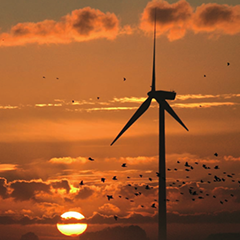With an estimate of nearly a quarter of a million birds killed by monopile turbines in the US alone every year, there’s no doubt that it’s an issue that needs to be taken seriously by the industry. But as turbines get taller, is it a growing issue? We present the very latest research from the Smithsonian Conservation Biology Institute and the U.S. Fish and Wildlife Service.
Wind energy has emerged globally as a promising alternative to fossil fuels. As of last year, more than 270 gigawatts (GW) of power generation capacity were installed across the world’s >13,000 wind facilities (The Wind Power, 2013). Roughly 20% of this capacity is installed in the United States (American Wind Energy Association, 2013), providing enough energy to power 18 million households. A continued increase of U.S. wind energy development is expected in response to the Department of Energy’s (DOE) goal to have 20% of total energy generated from wind power by 2030 (U.S. DOE, 2008).
Conservationists have expressed concern about direct and indirect impacts of wind energy development on wildlife, including bird and bat collisions with wind turbines, habitat loss, and creation of barriers to wildlife movement. Despite the decommissioning of many lattice-tower turbines that have caused large numbers of bird collisions, such as those at Altamont Pass in California (California Energy Commission, 1989; Smallwood and Karas, 2009), bird collisions still occur at turbines with solid monopole towers, which now comprise the vast majority of U.S. turbines.
Wildlife mortality from collisions with wind turbines is the most direct, visible, and well-documented impact of wind energy development. However, conclusions about collision rates and impacts of collisions on bird populations are tentative because most of the mortality data is in industry reports that are not subjected to scientific peer review or available to the public.
The accessible data – which could provide a non-representative sample of all studies – suggests that bird collision rates at turbines are lower than at other structures, such as communication towers, buildings, and power lines (Drewitt and Langston, 2006), and that mass collision events are rare at wind facilities. Pre-construction assessment of collision risk at proposed wind facilities has been unreliable, with no clear link documented between predicted risk levels and post-construction mortality rates, likely due to substantial variation in collision rates among turbines and a failure to consider risks at individual proposed turbine sites.



























